Key takeaways:
- Emphasizing both quantitative (like team velocity) and qualitative (like pulse surveys) metrics fosters a deeper understanding of team growth beyond mere numbers.
- Setting specific, measurable goals using the SMART criteria empowers teams and enhances accountability, leading to greater satisfaction and achievement.
- Regular performance reviews and celebrating successes create a culture of open communication and recognition, strengthening team cohesion and motivation.
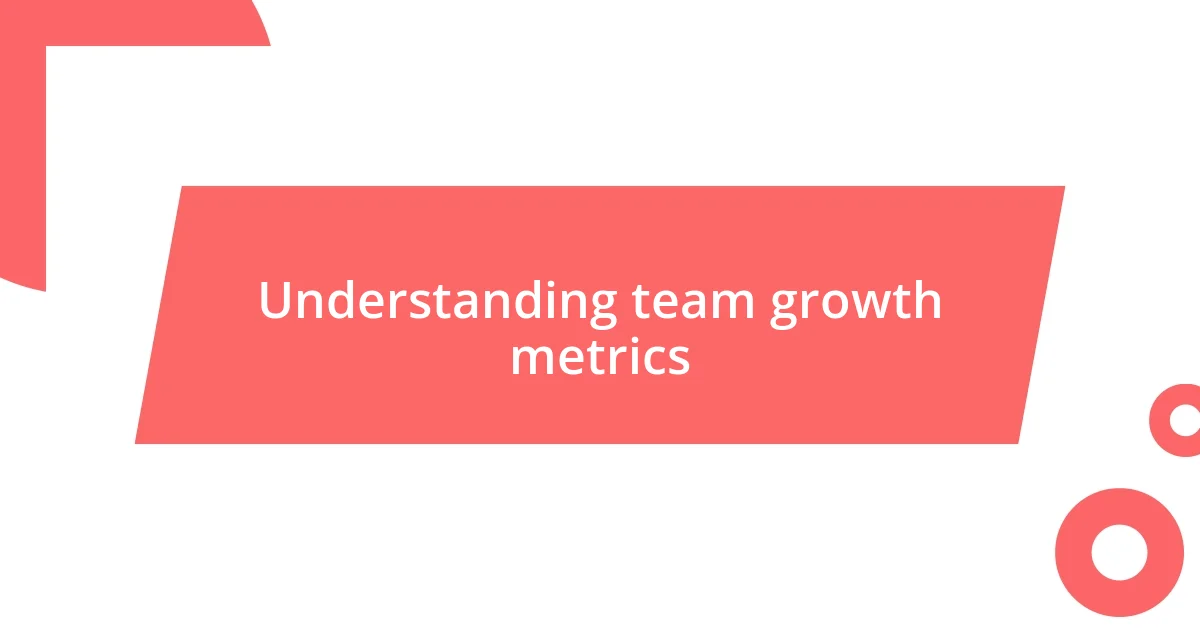
Understanding team growth metrics
When it comes to understanding team growth metrics, I often find that clarity is key. For example, I remember a time when my team struggled to define what growth really meant for us. We sat down and collaboratively decided that growth wasn’t just about numbers; it was also about collaboration and morale. Have you ever experienced a shift in perspective that changed how you measure success?
One metric that I find particularly insightful is team velocity, which reflects how much work we can accomplish in a given timeframe. I recall a sprint where our velocity dipped unexpectedly, and instead of panicking, we took it as a learning opportunity. It sparked conversations about workload balance and task allocation. This, in turn, led to improvements in our workflow and ultimately made our team stronger. Don’t you think that understanding the story behind the numbers is what really fuels growth?
Another aspect I cherish is qualitative feedback, like team members sharing their feelings about their contributions. I once introduced a simple pulse survey that allowed everyone to express their thoughts anonymously. The results were eye-opening! It not only highlighted areas for improvement but also revealed how team members felt valued and connected. This dual approach—mixing quantitative and qualitative insights—has truly transformed how we view our growth metrics. How do you gauge the emotional pulse of your team?
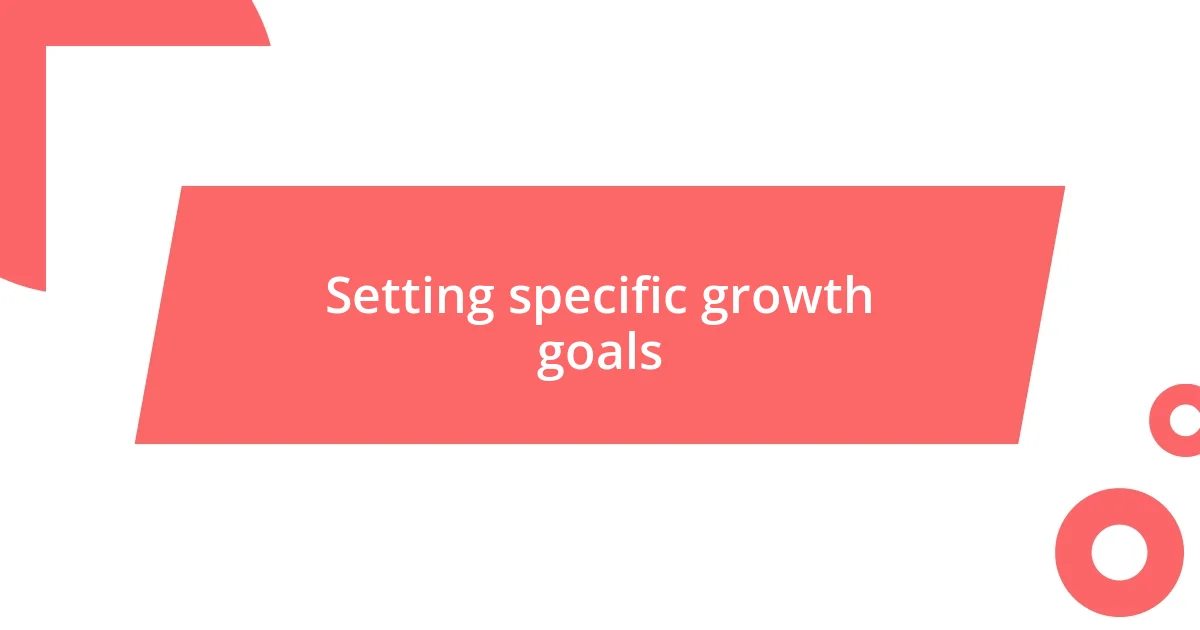
Setting specific growth goals
Setting specific growth goals is essential for guiding our team’s development. I remember a time when we aimed for broad objectives—like “improve communication.” This vague target made it difficult to assess our progress. Eventually, we decided to break it down into measurable goals. We aimed to initiate bi-weekly team check-ins and implement a collaborative tool for project updates. It felt empowering to see tangible steps towards a better connection.
To ensure our goals were on point, I found it helpful to use the SMART criteria, which stands for Specific, Measurable, Achievable, Relevant, and Time-bound. By applying this framework, we could clearly articulate our growth objectives. Here’s how we refined our goals:
- Specific: Define concrete outcomes, like increasing project updates by 25%.
- Measurable: Identify metrics that track progress, such as the number of completed tasks.
- Achievable: Set realistic targets that consider our current capabilities.
- Relevant: Ensure each goal aligns with our overall team mission and values.
- Time-bound: Establish a clear deadline for each goal, creating urgency and accountability.
Adopting this approach not only made our growth aspirations clearer but also ignited a sense of purpose within the team. I can still recall the excitement as we crossed each mini-goal off our list—it felt like a shared victory! What specific growth goals do you find effective for your teams?
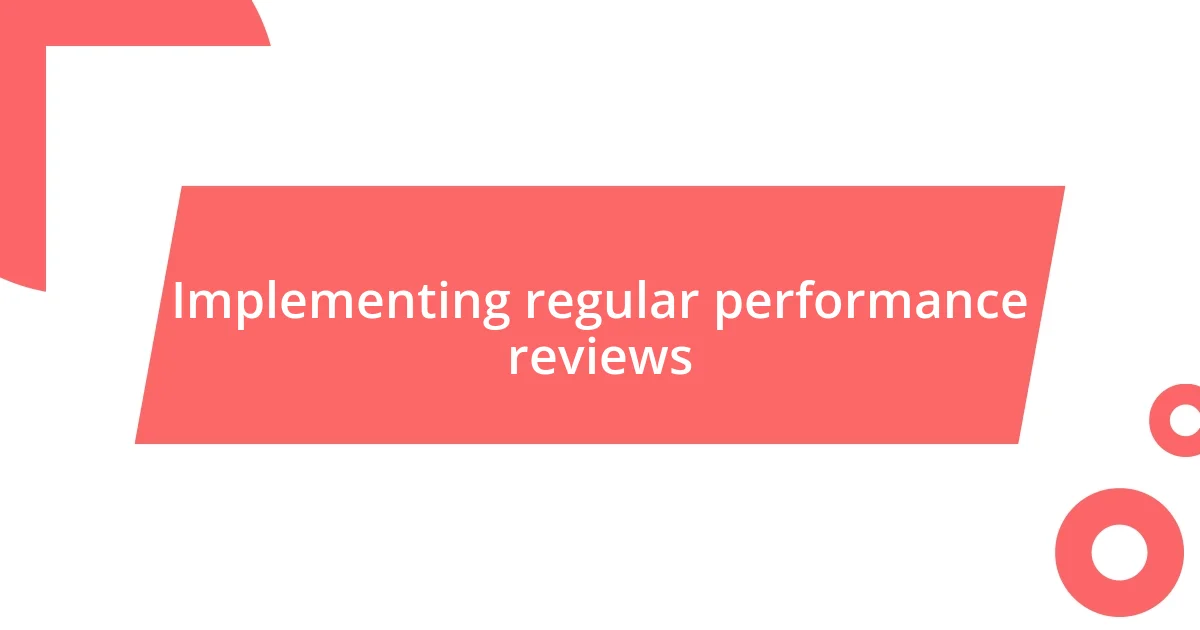
Implementing regular performance reviews
Implementing regular performance reviews has been a game-changer for my team. I’ll never forget the first time we decided to adopt a structured review process. Initially, I was worried about how my team would react; would they see it as a chore or as a valuable opportunity? To my pleasant surprise, the reviews turned into meaningful dialogues that led to personal growth and team cohesion. Such transformations can be so invigorating, don’t you think?
During these reviews, we focus on both achievements and areas for improvement. I had a teammate who was hesitant to share feedback, believing that only negativity would arise. However, when we provided a safe space for honest conversations, he opened up about his aspirations and challenges. In that moment, not only did we celebrate his contributions, but we also mapped out a path for his development. It’s fascinating how creating an open atmosphere can boost team morale.
One practice we adopted was the ‘360-degree feedback’ approach, where everyone, including peers and supervisors, shares their perspectives. I remember the first time we tried it; the honesty was refreshing. While some of the feedback was tough to hear, it paved the way for deeper understanding among us. I realized that these conversations foster trust and respect, ultimately leading to a stronger team dynamic. Do you find that embracing candid feedback helps cultivate an environment of growth in your work culture?
| Performance Review Elements | Benefits |
|---|---|
| Structure | Creates clear expectations for both managers and team members. |
| Honest Conversations | Fosters a transparent environment that encourages sharing and learning. |
| 360-degree Feedback | Provides diverse perspectives, increasing self-awareness within the team. |

Utilizing feedback for improvement
Utilizing feedback for improvement has proven to be one of my most effective strategies. I recently conducted an informal survey after a major project to gather insights from the team. The results were eye-opening! Some team members shared they felt unsupported during peak times. I hadn’t realized this was an issue until I asked. It made me reflect: what important feedback are we missing by not reaching out?
In another scenario, I remember leading a brainstorming session where I encouraged every voice to be heard, even the quieter ones. One timid member shared an idea that sparked a lively discussion and turned into a pivotal part of our project. Their sense of relief and pride was palpable! It was a reminder that capturing feedback isn’t just about collecting data; it’s about creating an environment where everyone feels valued. How do you encourage contributions from every voice on your team?
Embedding feedback into our routine processes, like during our project retrospectives, has also been a game-changer. I remember the first time we implemented this—team members were cautious at first, but eventually, the discussion flowed freely. We dissected what went well and identified pitfalls together. That collective ownership of feedback transformed how we approached future tasks. It made me wonder, does your team have a structured way to reflect on their experiences and implement learnings?
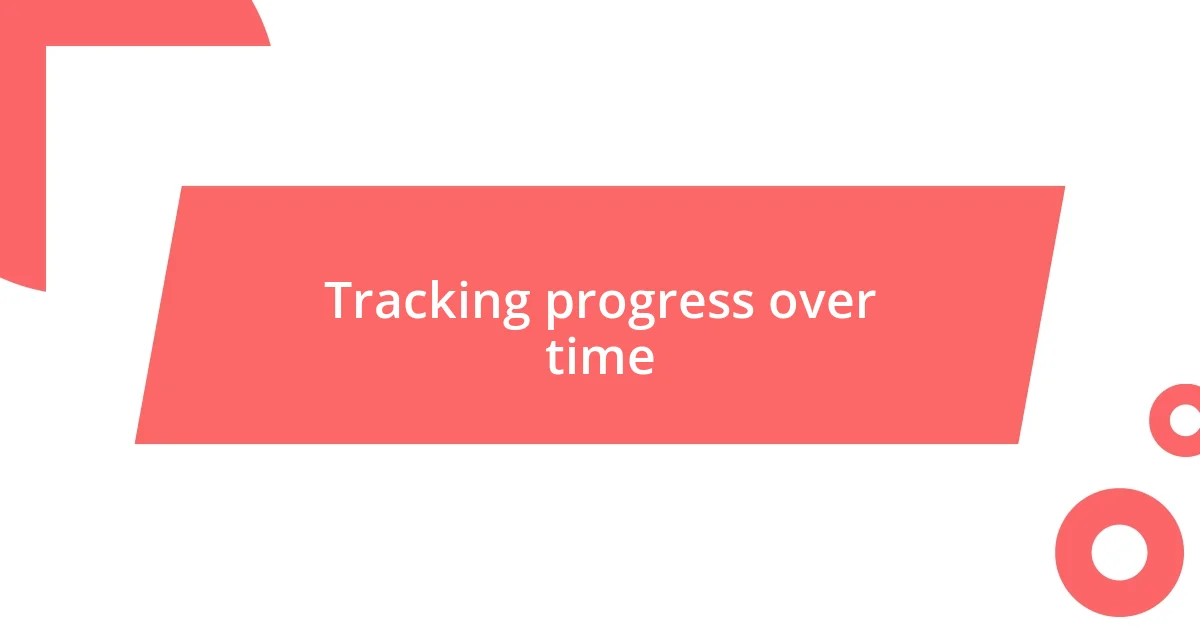
Tracking progress over time
Tracking progress over time is essential for understanding the trajectory of team growth. I’ve found that maintaining a timeline of individual and team achievements not only highlights milestones but also sparks motivation. Seeing how far we’ve come together often reignites passion and commitment within the group. Does your team have a way to visually showcase its progress?
I remember when we first implemented a shared dashboard to log our accomplishments. At first, it seemed like just another task, but soon it became an inspiring visual reminder of what we could achieve. One day, a team member pointed to a significant drop in project turnaround time since we’d started using time management tools. That revelation filled us with pride and encouraged us to set even more ambitious goals. Have you considered how visual tools can enhance engagement within your team?
Incorporating monthly check-ins has also been instrumental in tracking our growth. During one of these sessions, we revisited our initial objectives and analyzed how closely we aligned with them. I was amazed at how these discussions, often filled with laughter and renewed insights, turned into collective brainstorming sessions. It’s in these moments of reflection that we identify not just our progress, but also the opportunities for future development. Have you ever experienced a moment of clarity when revisiting your team’s past achievements?

Analyzing individual contributions
Assessing individual contributions is crucial for appreciating how each team member adds to our collective success. I recall a time when we held one-on-one discussions to evaluate everyone’s roles in a challenging project. It was enlightening to hear how personal efforts, often unseen, had a domino effect on our overall performance. Have you ever taken a moment to recognize the impact of those subtle contributions in your team?
In another instance, I witnessed a remarkable transformation during our feedback sessions. A colleague, initially hesitant to share, blossomed with confidence once they saw their ideas were valued. It struck me how individual contributions not only shape outcomes but also foster a sense of belonging within the team. I often wonder, how often do we celebrate the small wins that encourage our quieter team members to step forward?
I’ve also learned the value of keeping detailed records of each person’s contributions on projects. During our biannual reviews, it was illuminating to see how certain individuals consistently went above and beyond, even if their efforts weren’t always in the spotlight. This practice helped us identify skills and strengths that might otherwise remain unnoticed. Isn’t it fascinating how recognizing these contributions not only boosts morale but also guides future development paths?
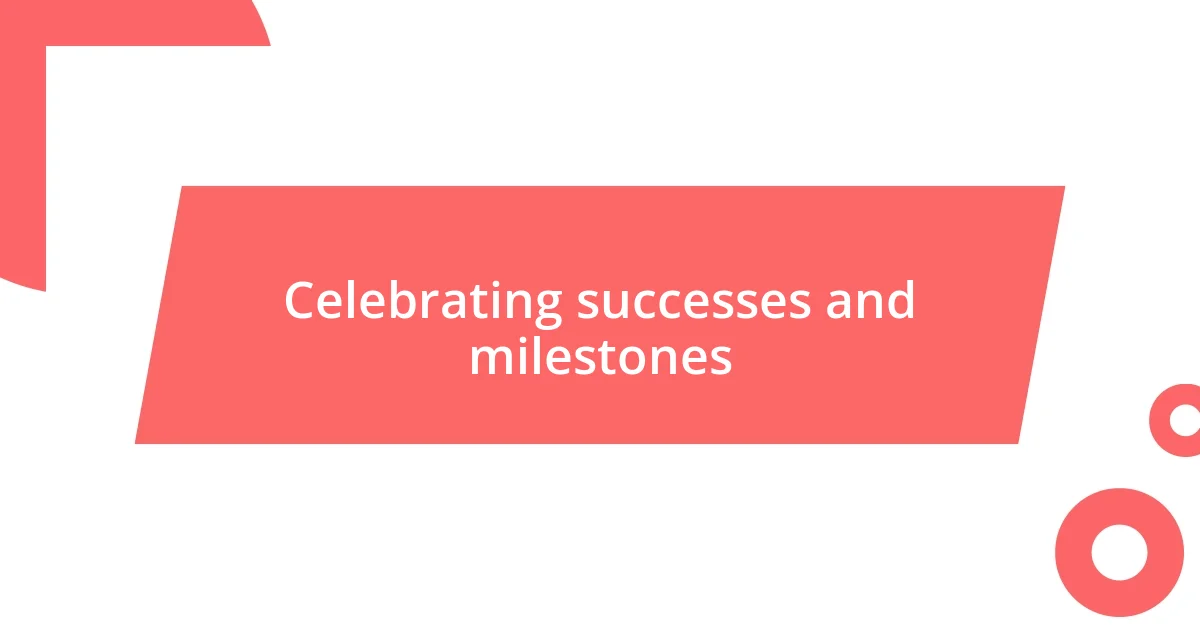
Celebrating successes and milestones
Celebrating successes and milestones is a powerful aspect of my team’s growth journey. I distinctly remember the day we wrapped up a project ahead of schedule. As we gathered to celebrate with a small team lunch, I felt a sense of pride swell within me. There’s something incredibly motivating about acknowledging our hard work together. How does your team mark those critical achievements?
Engaging in these celebrations not only highlights our accomplishments but also strengthens our bond. I noticed during one particular event, where we shared personal stories about the challenges we overcame, that laughter filled the room. It reminded me that, amidst the chaos of deadlines and targets, it’s those shared moments of joy that fuel our collaboration. How do your celebrations create a sense of unity among your team members?
Reflecting on our successes has become a staple of our culture. I’ve found that taking the time to recognize progress not only boosts morale but also sets the stage for future innovation. For instance, last quarter, we celebrated not just our completed projects but also the interpersonal growth we experienced as a team. Seeing my colleagues beam with pride, I realized that these moments deepen our commitment to pushing each other further. What strategies have you developed to ensure your celebrations leave a lasting impact?















